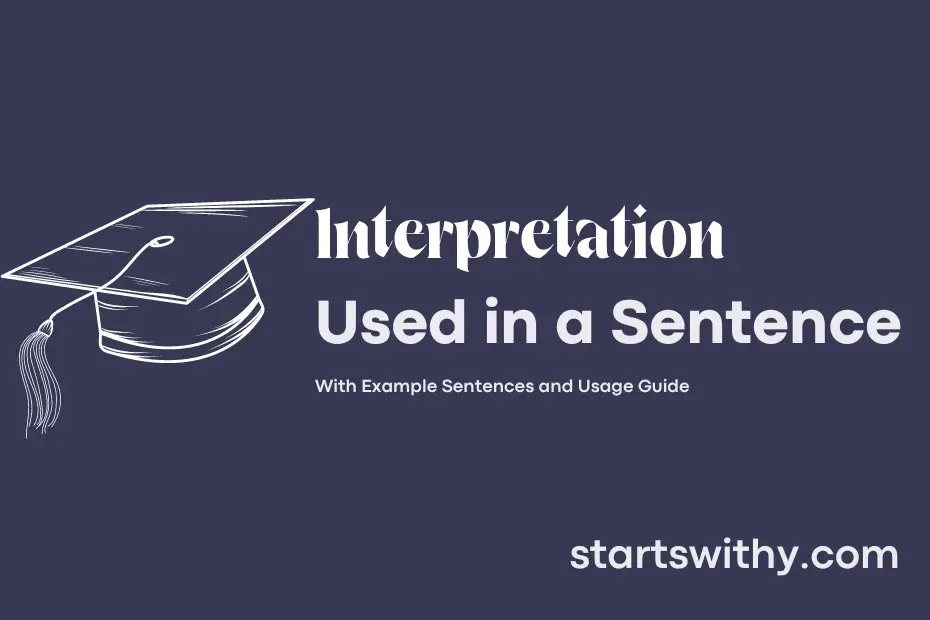Let’s unravel the art of interpretation! Interpretation is the act of explaining, translating, or deciphering the meaning and significance of something, whether it be a piece of literature, a piece of art, a situation, or a conversation. It involves analyzing the information given and providing insights based on context and understanding.
Every interpretation is a unique perspective that sheds light on the complexities of communication and perception. It allows us to extract deeper meanings from our interactions and experiences, leading to enriched understanding and fostering connections.
7 Examples Of Interpretation Used In a Sentence For Kids
- The interpretation of a story helps us understand it better.
- Colors in art can have different interpretations.
- Interpretation means explaining something in your own words.
- We can have different interpretations of the same picture.
- When we read a poem, we can make our own interpretation of what it means.
- People may have different interpretations of the same song lyrics.
- Our interpretation of a movie can be influenced by our feelings and experiences.
14 Sentences with Interpretation Examples
- Students are often required to provide their own interpretation of literary texts in English literature courses.
- In history classes, professors ask students to analyze primary sources and offer their interpretation of events.
- Interpretation of data is a crucial aspect of research projects in the field of science.
- Understanding cultural symbols and their interpretation is important in anthropology studies.
- In art classes, students are encouraged to explore different styles of interpretation through their creations.
- Political science students often debate the interpretation of laws and policies in their courses.
- Interpretation of financial statements is a key skill taught in accounting classes.
- Psychology students study the brain’s interpretation of sensory information in cognitive psychology courses.
- Interpretation of statistical data is essential for students studying economics.
- Students learn about different religious texts and their interpretation in religious studies courses.
- In philosophy classes, students are challenged to develop their own interpretation of complex philosophical texts.
- The interpretation of historical events can vary depending on the perspective of the historian.
- Students in film studies analyze films and offer their interpretation of the director’s vision.
- Interpretation of legal cases is a critical skill for students studying law.
How To Use Interpretation in Sentences?
Interpretation is the process of explaining the meaning of something. When using the word interpretation in a sentence, keep in mind that it usually involves providing your understanding or explanation of a particular situation, text, or event. Here are some tips on how to use interpretation effectively:
-
Choose the right context: Make sure the way you use the word interpretation matches the situation you are referring to. Whether it’s about analyzing a piece of art, understanding a dream, or explaining data, clarity is key.
-
Be clear and concise: When using the word interpretation, express your thoughts in a straightforward manner so that others can easily grasp your explanation. Avoid using overly complex language or vague descriptions.
-
Support your interpretation: Back up your interpretation with evidence or reasoning to make it more convincing and reliable. This helps others understand why you have come to a specific understanding of the subject.
-
Consider different perspectives: Recognize that interpretation can vary depending on the individual’s background, experiences, and beliefs. Be open to exploring multiple viewpoints and acknowledging different ways of understanding a situation.
By following these guidelines, you can effectively incorporate the word interpretation into your sentences and communicate your thoughts clearly and accurately. Remember that practice makes perfect, so continue to refine your interpretation skills through discussions and analysis.
Conclusion
In conclusion, the sentences with interpretation provided in this article illustrate the importance of context and analysis in understanding meaning. By examining various examples, it becomes clear that interpretation can significantly impact how a sentence is understood. Whether it’s decoding a complex phrase, uncovering hidden symbolism, or deriving a deeper message, interpretation plays a crucial role in grasping the full significance of written or spoken words.
Through the exploration of sentences with interpretation, it is evident that language is nuanced and open to multiple meanings. This highlights the need for careful consideration and critical thinking when deciphering texts. The art of interpretation not only enriches communication but also fosters a deeper connection with the message being conveyed, enhancing our ability to engage with and appreciate the richness of language.



